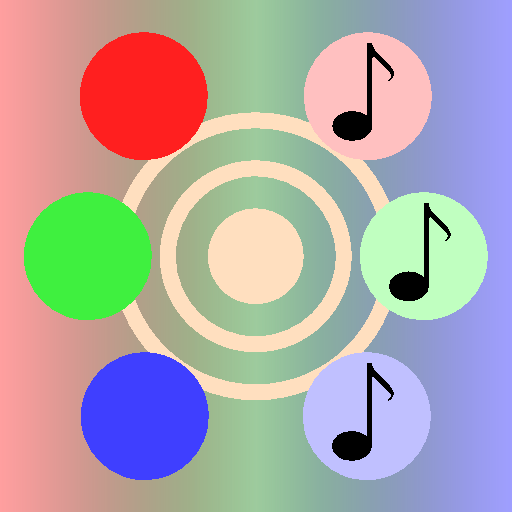|
Total Solar Eclipse - August 21, 2017: Images and Videos
|
Listed below are links to video clips and images taken with various optical systems
and Nikon cameras of the August 21, 2017 total solar eclipse. The location for
these videos/images was Bessemer Bend, a remote area about 15 miles southwest of
Casper, Wyoming.
I had the much-needed assistance of a co-worker (Mike Contreras), a daughter and her
husband (Nicole and Mike Harris), and their two children.
Click on a picture below to see the full image or video
|
|
Eclipse Totality Images and Videos
|
Image: Total Eclipse with Corona, 55mm lens
This image is a composite of a dozen images taken during totality with the first Nikon lens I ever bought (in 1974!).
It is actually the result of an error in a script I was running that was supposed to be taking a number of different
exposures during totality, but ended up taking all the exposures at the same speed (1/125 second). Since this turned
out to be a good exposure time to get most of the solar corona without over-exposing the central portion, the result
was a series of images I could composite together to reduce digital noise and somewhat make up for the relatively
short focal length.
The combined image nicely shows some detail within the corona, with small radial streamers and interesting detail
in the larger structures within the corona.
|
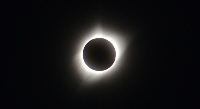
|
Video: Totality, 1,250mm telephoto lens (46 seconds)
This video covers that final 30 seconds or so of the totality phase of the eclipse.
It was taken through a Celestron C90 scope which was being used to project a nice large sun
image on a 42" flat-screen TV for visitors to the observing site. For the partial phases of
the eclipse, the scope was covered with a solar filter. With things being overly hectic during
totality, I almost forgot to remove the filter during totality to record the corona in natural
light. Luckily, I remembered to do so about 30 seconds before the end of totality, and was
rewarded with this video showing remarkable detail in the corona, though the very inner portion
is over-exposed.
One thing I had noticed while watching the sun with the naked eye near the end of totality was
a distinct red edge on the side where the moon was about to uncover the sun. I can be heard in
the video at about 34 seconds saying "Wow, that red is amazing, isn't it?" I don't believe I've
heard this phenomenon being described in other eclipses, and wonder if it's common and just new
to me, or if some aspect of this eclipse was unique. You can see the upper right edge of the
moon shadow area developing a distinct red line of color just before the end of totality, at about 30 seconds
into this video.
|
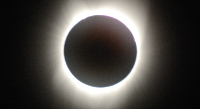
|
Video: Totality, 200mm telephoto lens (3 minutes)
This video was taken with a 200mm telephoto lens on a fixed mount, and starts just before totality begins.
Because the camera is on a fixed mount, the sun/moon image moves (in the upper right direction) during the
video. This was fortunate because the fixed mount wasn't quite pointed correctly at the beginning, but the
sun/moon moved toward the center during the video.
While the central portion of the corona is over-exposed, the outer portion shows three distinct prongs,
two to the upper right and one to the lower left.
At 2:41 in the video, just as totality is ending, a large bird is seen flying across the sun/moon image.
It is not unusual for some animals to be confused by the sudden darkness, and for them to act a little out of
the ordinary. Shortly after totality ended I saw a flight of geese nearby, something that is more typical
of evening than mid-day activity.
|
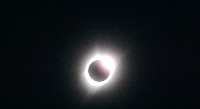
|
Video: Totality, 55mm normal lens (3 minutes)
This video was taken with a 55mm lens on a fixed mount, and starts just before totality begins.
A thin cloud layer can be clearly seen in the early part of the video, though these clouds did not in any
significant way interfere with observing the eclipse.
The lighter sky background in this video is a more accurate reflection of the visual appearance of the
eclipse during totality, as the sky itself was not really dark, but rather a lovely opalescent dark blue
color.
The inner corona is again over-exposed in this video, but the three prongs in the corona are quite pronounced.
At about 2:40 on the video, just as totality is about to end, you can clearly see the shadow of the moon on
the thin clouds sweeping from right to left, as the clouds brighten first on the right and then quickly
brighten across the visual field. The same effect is seen at the beginning of the video at about 8 seconds,
as the dark shadow of the moon sweeps across the clouds from right to left just as totality is beginning.
|
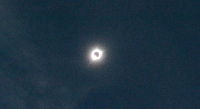
|
Video: Totality Surroundings (West), 18mm wide lens (5 minutes)
This video was taken with an 18mm lens facing west on the group of eclipse observers at Bessemer Bend.
It begins at about 2 minutes before totality begins.
At about 1:40 on the video you can notice the clouds getting significantly darker as the shadow of
the moon rushed from west to east toward the group. Similarly, you'll notice these same clouds getting
brighter beginning at about 3:30 on the video, and they are bright white by the time totality ends at
about 4:25 on the video.
|

|
Video: Totality Surroundings (East), 18mm wide lens (5 minutes)
This video was taken with an 18mm lens facing east on the group of eclipse observers at Bessemer Bend.
It begins at about 90 seconds before totality begins.
The moon shadow on the clouds is reversed from the above video since this camera was pointed east rather
than west. At the beginning of totality at about 1:37 on the video the clouds are still bright white,
but then get very dark over the next minute or so as the moon shadow overtakes them.
|
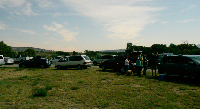
|
|
Eclipse Partial Phase Videos - 1,250mm lens
|
Video: Before start of eclipse (15 seconds)
This series of videos was taken through a Celestron C90 scope with a Nikon D3100 camera in movie mode.
The scope/camera was mounted on a Meade LXD75 equatorial mount, which if accurately positioned
would closely follow the sun. We did, in fact, spend some time getting the mount level and as
close to true North alignment as possible, but then discovered that we were too far from our
power source and had to move the whole mount just prior to the eclipse. Given the uneven turf,
this resulted in a misaligned scope, which is why the sun can be seen to drift in these videos.
The quicker sun movements, of course, are from one of us using the mount controls to re-center
the sun image.
This first video is of the sun immediately before the beginning of the eclipse. There are three
sunspots visible on the sun throughout, just above the center of the sun.
We had set up a 42" flat-screen TV in the grass next to the scope, and connected the camera to
the TV via an HDMI cable. This allowed other visitors at the observing site to comfortably see
the progress of the eclipse without always looking up with their eclipse glasses. We had black
felt cloth on the ground in front of the TV to limit reflections on the TV screen, and the whole
setup worked pretty well.
|
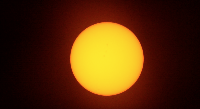
|
Video: Partial Phase - Part 1 (30 seconds)
This next video is a couple of 15 second clips merged together of the beginning of the partial
phase of the eclipse. You will notice the "bite" of the moon out of the sun's image getting a
bit bigger with each succeeding clip.
|
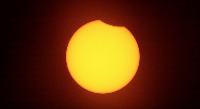
|
Video: Partial Phase - Part 2 (45 seconds)
This video has three 15 second clips, showing further progress of the partial eclipse phase.
|
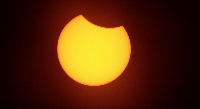
|
Video: Partial Phase - Part 3 (15 seconds)
This video has one 15 second clip, showing further progress of the partial eclipse phase.
|
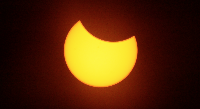
|
Video: Partial Phase - Part 4 (60 seconds)
This video has four 15 second clips, showing further progress of the partial eclipse phase.
In the third clip (30 to 45 seconds) you'll notice that the background is brighter, and you can
see a little evidence of the thin clouds passing in front of the sun during the eclipse at our
location.
|
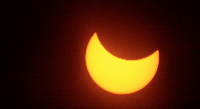
|
Video: Partial Phase - Part 5 (30 seconds)
This video has two 15 second clips, showing further progress of the partial eclipse phase.
|

|
Video: Partial Phase - Part 6 (75 seconds)
This video has five 15 second clips, showing further progress of the partial eclipse phase.
|
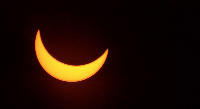
|
Video: Partial Phase (through totality) - Part 7 (4 minutes)
The first minute of this clip shows the end of the partial phase of the eclipse, as the moon fully obscures the
disk of the sun. It then skips about 90 seconds of real time of totality, when I finally remembered to remove
the filter from the scope to show the sun and corona in their full glory.
There is a bit of maneuvering of the image to center it at the beginning of this portion of the clip as we tried
to center the image in the camera and on the TV screen.
There is a lot of detail visible in the corona from about 1:15 to 1:40 on the video.
At about 1:43 on the video, just before the end of totality, there is a distinct red line on the edge of the
moon at the upper right portion where the moon is beginning to uncover the inner portion of the sun's atmosphere.
This red line was clearly visible to the naked eye as the total eclipse was ending.
At about 1:48 on the video, as the sun's light was beginning to overwhelm the camera, I replaced the filter so as
not to damage its sensor. The remaining two minutes of this video shows the moon slowly begin to uncover the sun
as the second partial eclipse sequence progresses.
|

|
|
Eclipse Equipment Preparation and Setup
|
Testing cameras and computer operation at home
I'd been planning and preparing for this eclipse expedition for a year and a half.
While I've been an astronomy
enthusiast for over five decades, this was to be my first chance to see a total solar eclipse, and I was determined
to make the best of it.
I developed an overly aggressive plan to take images and videos of the eclipse through a number of cameras, using
different telescopes and camera lenses. While I had some basic equipment already, I went on an eBay buying spree to
inexpensively gather together a total suite of 18 Nikon cameras.
It would be impossible, of course, to manually control
all of these cameras at the time of the eclipse, so I resorted to a camera control program named DigiCamControl running
on laptop computers. About half of the cameras were connected via USB wires to one of two laptop computers. One computer
was driving six cameras in a time-lapse sequence throughout the eclipse, while another had a script loaded onto it to
take multiple exposures of different lengths during the totality phase of the eclipse. The other cameras were used for
taking videos, and they did not have the capability of having a video started via computer, so that process had to be
a manual one performed during the eclipse.
Shown in this picture are the full set of cameras, laptops, and connections arranged for bench-testing in my living room.
|
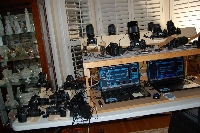
|
Equipment shoehorned into Avalanche pickup truck bed
I have a full-sized pickup truck (Chevrolet Avalanche), and it took a full day of meticulous packing
and arranging to fit everything into the bed of the truck, as shown here.
Since I would be driving across country (from Pennsylvania to Nebraska), I wanted to have all of the
equipment secured in the bed where I wouldn't have to worry about prying eyes and larcenous hearts
along the way.
|

|
Unloading and setting up equipment at Bessemer Bend site
My co-worker Mike Contreras (seen smiling in this photo) and I drove to North Platte, Nebraska,
arriving on the evening of August 18th. The plan was to spend some time scouting out the viewing
area we had chosen at the Logan County fairground in Stapleton, Nebraska.
We also met up with my daughter, her husband, and two children in North Platte, and spent the 19th
in and around Stapleton (fun rodeo on Saturday evening!).
However, the weather forecasts for the 21st for the Stapleton area were very unsettled, with an excellent
chance of overcast skies, and only a modest chance of seeing the eclipse from there. We all decided late
on the 19th to drive the next day to Casper, Wyoming, where the weather forecast called for a near-certainty
of clear skies.
Arriving in Casper (350 miles from North Platte) on the afternoon of the 20th, we began looking about for a
suitable place to setup the truck and camera/telescope equipment. We weren't having any luck finding such a
spot in the city, but Mike located a spot about 15 miles southwest where he had heard there were signs in
ranchers' yards inviting eclipse observers. While we didn't find those signs, we did find an ideal spot in
Bessemer Bend, a kink in the North Platte (coincidence?) river, which is where this photo was taken at about
6:00am on the morning of the 21st (eclipse day).
We had a fairly flat grassy area to place the truck correctly (pointed roughly at where the sun would be during
totality), with plenty of room around to place our ancillary equipment.
|

|
Equipment loaded onto "Eclipse-Zilla" truck, ready for business
As the morning progressed, were were joined by several dozen other eclipse viewers who had also found our
ideal spot, and we were thrilled to have the company.
This picture shows the equipment assembled and ready for use:
- at the left rear of truck, a Meade ETX125 scope and Nikon 500mm Nikkor lens, both mounted on a Meade
LXD75 equatorial telescope mount.
- at the right rear of the truck, a Celestron C90 scope mounted on a Meade LXD75 equatorial telescope mount.
- just to the right of the Celestron C90 scope, a 42" flat-screen TV showing the image from its camera throughout
the eclipse.
- on the top of the truck cab, two makeshift plywood camera mounts, each carrying three Nikon cameras
- on an open box mounted on the truck tailgate, three makeshift plywood camera mounts, carrying a total of eight
cameras
- inside the open box on the truck, two laptops wired to nine of the cameras.
- not well seen, but visible at the left side of the tailgate, a 100ah deep cycle battery and 500W inverter providing
plenty of power to the equipment during the eclipse.
- just below the power inverter by the left rear bumper - a non-connected power plug for the laptop driving six of the
cameras, which ran on battery power up through the first minute of totality and then gave up. We had replaced this
laptop just before the eclipse began and inadvertently failed to connect the power cord...
- not seen here, but I'll add pictures as I get them from Nicole, we had a "Pinhole Art" desk set up for kids to make
simple line drawings and push-pins to get neat eclipse-time pinhole art shadows. Also, we had a kids binocular location
with beach blankets and small 8x20 filtered binoculars to look at the partial eclipse with.
|
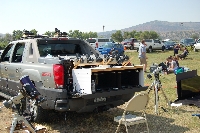
|
Mike Harris adjusting sun position on 42" flat-screen TV
This picture shows the 42" flat-screen TV we had running during the eclipse, showing the progress
as it was being recorded on the camera attached to the Celestron C90 scope. The black felt cloth
in the foreground kept down reflections on the TV screen so that the image could be clearly seen.
|
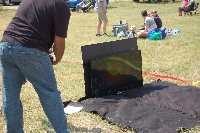
|
Post-Mortem Review
As mentioned above, we had 18 cameras planned to film the eclipse. In the end, we only got useful images
and videos from 9 of the cameras, and these are what is shared above on this page.
The other 9 cameras, through a series of both technical and user errors, failed to produce useful images
or videos. You name it, it happened - cameras not focused, cameras not pointed properly, memory
card not inserted in a camera, videos not manually started, loss of power in driving laptop.
So what we have is the perfect glass-half-full/glass-half-empty scenario. In retrospect, I'll go with the
glass-half-full conclusion. Overall we had an amazing adventure, got a very nice array of good images and
videos, and most importantly, saw with our own eyes one of the most unique, unusual, and beautiful sights available to mortal man.
|
|
